A bear encounter is a treacherous fact of life in the Rocky Mountains. What’s more, if you come from the UK (or most city areas), you probably have no idea what to do to protect yourself from bears. Perhaps you think the best thing to do is to run as fast as you can!! Hell, no! My gruff park ranger in the tourist information office sternly warns me against ‘fast food’. He means me of course! It seems any attempt to run, cycle or move fast is an invitation to become bear dinner in these parts.
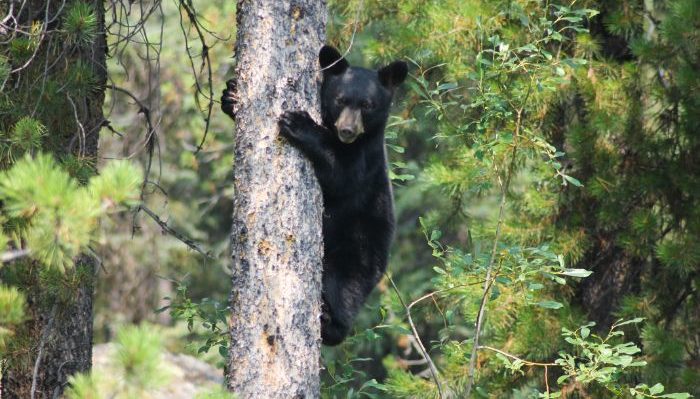
Jabbing his finger at me across the counter, he looks with disdain as I explain my plans. Horrified, he commences a stern education on the wildlife of Alberta as he slaps brochure after brochure on the counter. To save you a similar embarrassment, let me share his tips to protect yourself from bears and other wildlife in the Rockies.
Wildlife in the Rockies
Bears
The first leaflet he thrusts into my hand is ‘Bears and People’.
‘First’, he says ‘you need to watch out for bears’.
‘Well, surely they do not come into town?’ I reply astonished, thoughts of hiking conveniently forgotten. Frowning, he unfolds a map of the area and puts a big red cross on a road adjacent to our hotel.
‘I saw a bear here just the other morning’ he growls. ‘You must stay alert at all times. Do not wander alone at night and do not go into the woods without bear spray. You can hire it next door but if you see a bear, stay ten whole bus lengths away. You probably won’t need to use it that way.’
Truthfully, I think he is exaggerating but this is our first day in Jasper and what do I know? It turns out I know nothing about wildlife in the Rocky Mountains!
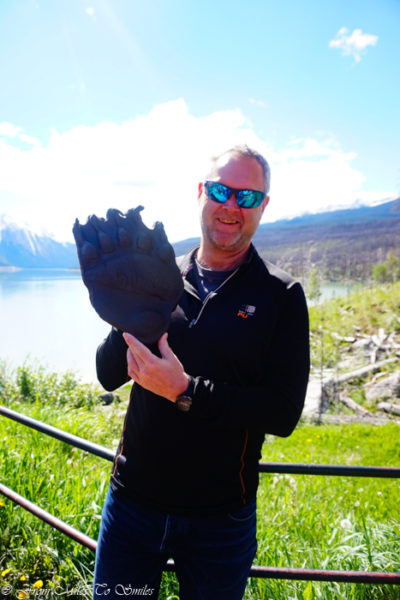
Elk
It appears however that bears are far from the only hazard in the Rocky Mountains. Mr Doom (as I now nickname him) pulls out another leaflet, this one entitled ‘Keep the Wild in Wildlife’. Ferociously, he stabs his finger at a picture of an elk and ruins all my positive Bambi memories.
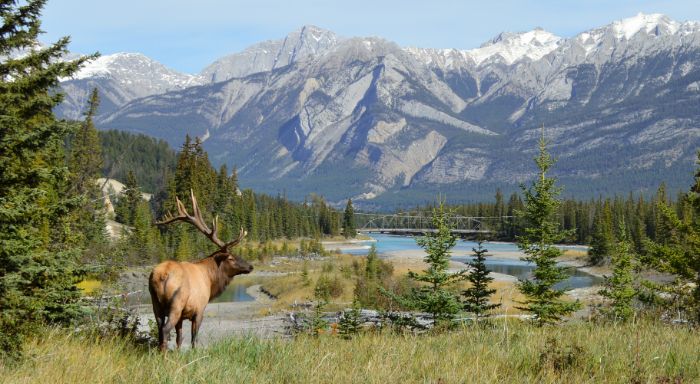
‘Now these beasts, they are the ones you really need to worry about. They are aggressive and will protect their young at any cost. You must stay at least 3 bus lengths away from these.’ I dare not ask why the distance is less for an animal that is more wild and vicious. Determined to witness the wildlife of Canada however, I politely inquire, ‘I can look at them from the road though right? Just keep 3 bus lengths in distance away from them?’. I can feel his irritation mounting as he glares at me. Spittle emerges from his mouth as he barks ‘young lady, these are not cartoon characters!’ (Ok, I can live with the young bit!) ‘The mothers will stamp on you to protect their young! You probably won’t survive an attack.’
Our first hike in the Rockies
Either this ranger is trying to keep foreigners out of Jasper or these animals are seriously dangerous. I quiver, contemplating the many possible deaths I might experience on a simple hike. I am no longer sure I want to leave the sanctuary of the tourist information. Even if this park ranger has a little to learn about a calm bedside manner.
Shaken, I exit and explain to Jason that it is far too dangerous to go into the big bad woods of Jasper. Our bones will almost certainly be discovered in years to come, identified by small remnants of our clothing. He is clearly as dubious as I as we saunter in the direction of the local trails (no bear spray in sight!!). We safely store the pamphlets in my backpack – evidently not much use if we need them! Thankfully this oversight spares us the details of more wildlife that might kill or maim us.
Our first elk encounter
It does not take long for us to discover the ranger might just be right. Five minutes out of town, Jason suddenly stops me. Already a little on edge, I think ‘damn, I forgot the bear spray’.
‘Look’, he says fervently, ‘there’s a whole herd of elk.’ Oh cripes! Maybe a hundred metres away, approaching the junction that we are heading towards, is a whole herd of elk. We shuffle backwards determined to establish a three bus lengths distance.
The leader of the herd is huge with whopping antlers and one hell of an attitude. She stands imperiously by the traffic lights, like royalty waiting for the masses to clear the path. The traffic slowly grinds to an halt and Queen elk leads her herd into the forest area immediately to our left.
At this point, we decide that perhaps we need to be less cavalier and go get the bear spray.
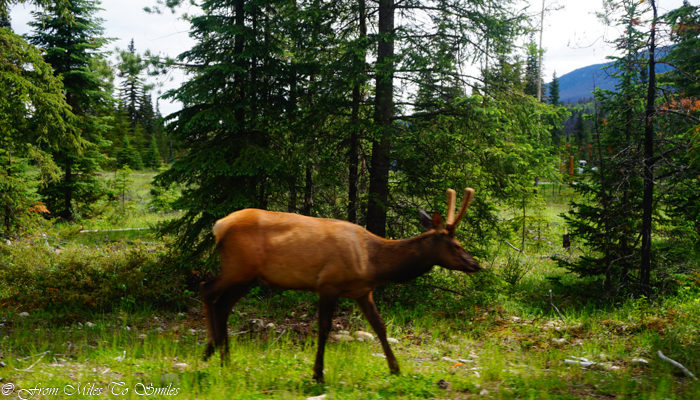
Bear spray
Unnerved, we retrace our steps into town to hire bear spray. Most stores only sell bear spray and at $50 a can, it is not cheap. Unless you plan to stay multiple days, it is better to hire. It costs around $10 a day and you must return it intact. If you use the canister, you pay for the canister. In the hiking shop we stress that we are much more likely to main ourselves with bear spray than prevent a bear attack. We need a lesson in bear spray use!!
The helpful shop assistant gives us instructions which consist of;
- Release the safety catch on top
- Ensure the bear is around 4 – 5 metres away (there’s a lot to think about in the event of a bear encounter!)
- Spray from top to bottom to create a protective shield
- Then make your escape
Jason looks confident as he attaches the spray to his belt and off we go again into the woods.
Important note
Note, whilst I have made light of my conversations with the ranger (and may have used a little creative licence), please be under no illusions. Bears kill as these recent examples in the Sky News and the Daily Mail highlight. Read the pamphlets, hire the spray and be bear aware. It is your responsibility to protect yourself from bears.
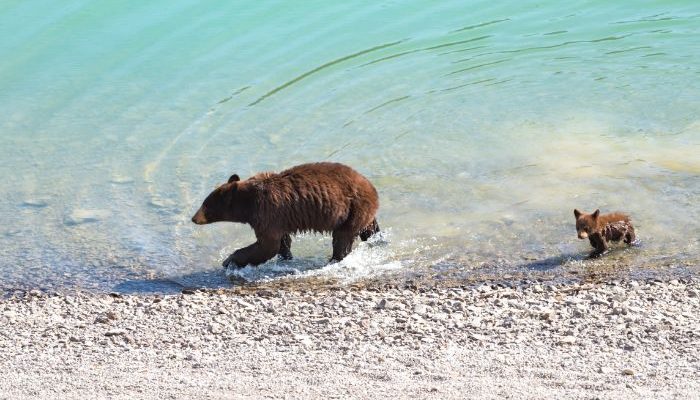
Other wildlife encounters
Our second elk encounter
A few days later, two younger looking elk (who am I kidding? I have no idea how old they are but they look smaller than mummy elk) decide to hang out in the shade of the roadside running trail. The exact same running trail that we planned to use for our evening route. Jason delightfully tells me that the cyclist made it past the elk unscathed and we should just risk it. I however recall the graphic depiction of the wrath of elk. ‘Nah, I think we can just hangout here for a few minutes and maybe they will move’ I say. I swear my personal trainer must really think my excuses for a slow run are becoming more elaborate by the day!
To be fair to the elk they soon move on and we resume our run. We spot countless other elk during our few days in Jasper and admire them from afar.
What to do in the event of an elk encounter
Here’s the advice for what to do in the event of an elk encounter courtesy of the tourist information leaflet.
- Female elk can be aggressive during calving season in May and June. Male elk can be aggressive in breeding season which is September to October. If you are as useless as I at wildlife identification, it is possibly safest to give elk a wide berth at any time of year. ‘Wild‘ animals can be unpredictable so why take the risk?
- Back away slowly from the elk especially if they appear to respond to your presence which is a strong indication that you are too close.
- If you drive in the Rockies, keep a look out for elk as they can suddenly run into traffic. Drive slowly and cautiously.
- The brochures also advise you ‘to not play dead’. Mmm, interesting advice.
But, hey what about the bears I hear you cry? You still have not told me what to do if I encounter a bear!
How to protect yourself from bears
Helpfully the tourist information leaflet advises that the best way to protect yourself from bears is to avoid encounters. Yep, that makes sense! The problem is that we want to see bears, we just do not want to become bear dinner!
How to avoid a bear encounter
With this in mind, it is probably fair to say that most of you would prefer to avoid close encounters on a walk, run or hike. So, local authorities advise visitors to:
- Travel in groups – i.e do not go for a walk or run on your own. You will be amazed at how many people ignore this advice on the trails.
- Make plenty of noise – not difficult for a chatterbox like me.
- Keep to marked trail and avoid the temptation to ignore any trail closures
If you do come into contact with a bear however, you should determine whether the bear is aware of your presence and whether it is defensive, non-defensive or predatory. Quietly move away if it is not aware of your presence.
If it is aware of your presence, this is where things can get tricky. Trying to determine the state of mind of a bear can be tricky. As a woman of a certain age, experiencing certain hormonal changes, I would liken this to asking my husband to figure out how safe he is based on my hormonal frame of mind. Experience tells me he is as clueless as I would be at identifying a bear’s mood. Unless you are a Dr. Doolittle type, I assume you might have a similiar issue.
If this is the case, default to the general guidance for a bear encounter.
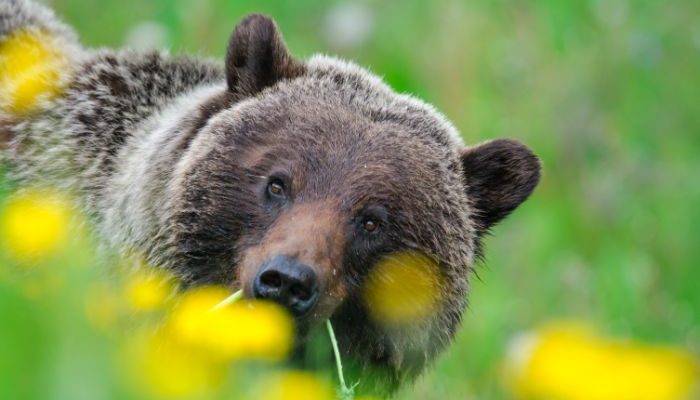
Bear encounter general guidance
This is to;
- Stay calm (easier said than done I know!)
- Talk calmly and firmly to the bear – I know this sounds crazy but this reminds the bear that you are human and not prey. Definitely better to be deemed bonkers!
- Make yourself appear big and back away slowly
- Do not drop any backpacks as you may need these for protection
Here comes the additional guidance points based on the bear’s behaviour.
Defensive bears
If the bear is with its young, it likely sees you as a threat. Follow the above guidance but if the bear advances, stand your ground, keep talking and use your bear spray. If the bear makes contact, fall on the floor and play dead! Surely a bear does not fall for that?? However, who am I to argue?
Non defensive bears
A non defensive bear may be curious, hunting for food or testing its dominance. Try to move out of the bear’s way but if it follows you, stop and stand your ground. Try to appear aggressive, try to intimidate the bear and use bear spray if necessary.
Predatory attack
If the bear appears predatory, try and escape to safety. Do not play dead, use your bear spray and fight back. Good luck!! I do not fancy my chances against a bear twice my size!!
If you spot bears whilst driving, stay in the car and observe from a safe distance. Give the bear space to forage and do not crowd. Remember, their safety and future is as important as ours.
Our bear encounters
So, surely what you really want to know was whether Mr. Doom was right? Is Jasper really over-run with bears in summer? In just 3 days in Jasper we see 6 bears in 4 separate encounters. That is way more bears than I ever expected.
In the woods of Old Fort Point
The first takes place at Old Fort Point which you can find on the Jasper day hikes leaflet. Shortly after we return to the woods with our bear spray, Jason heads into the washrooms with the bear spray. It is entirely possible that he would have to wrestle with a bear in the bathroom, I guess. Or, we are not quite as bear aware as we should be. I nonchalantly flick through emails on my phone on the outskirts of the woods.
Whether it is a rustle of leaves or a second sense that prompts me to turn and squint into the woods I cannot say. In the distance, I can make out a large dark shape and have to pinch myself. Is it another false alarm? Yet another large burnt tree stump instead of a black bear? The shape moves and rears onto its hind legs facing away in a somewhat aggressive looking pose. Hell, no! That is not a tree stump! It is our first bear sighting.
Our bear awareness
I beckon urgently to Jason as I clamber onto a stone to better see the bear as it crashes around in the undergrowth, presumably foraging for food. Note, in my elevated state of excitement at this sighting, I establish:
- The bear is unaware of our presence (Dr. Doolitle eat your heart out!)
- It is ten bus lengths away (I think!)
Nevertheless, we watch for a few seconds and decide not to push our luck. We decide to leave before the bear spots us and we then have to attempt to decipher bear behaviour.
As we return to the bridge we hear the bear heading towards us (definitely not ten bus lengths away any longer but still unaware of our presence. We think!) We back away from the woods and avoid a climb to the lookout in case the bear decides to corner us on the platform. Pretty exciting stuff for our first hike in the woods.
Bears in trees
The following day things get surreal. We hire a car and head to Maligne Lake. On our return, we spot a few cars on the roadside and a group of people on the tarmac peering upwards. Low and behold there is a black bear in the top of a huge tree chomping happily on leaves and shrubbery. Beneath her are three cubs mimicking their mother. We watch in fascination, hardly able to believe our eyes!!
Admittedly, we do not remain ten bus lengths away and these bears must be aware of our presence. However, they are considerably more focused on the challenge of eating their body weight in vegetation. We determine that we can race back to our car quicker than they can descend the tree but in any case, they clearly do not feel threatened. They all happily feast on the tree, indifferent to the gaggle of tourists creating life long memories.
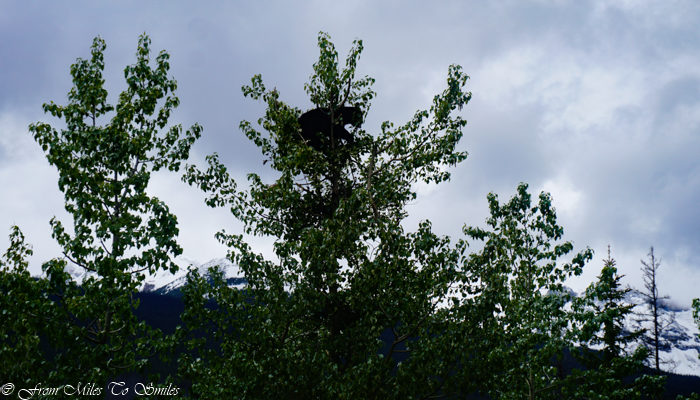
Bears on the road
Ten minutes later, as we ascend towards Jasper Skytram, we come across a grizzly bear who saunters casually across the road. We stay safely ensconced in the car and watch from a distance as he ambles into woodland and disappears.
Next day, as we make our way along the Icefield Parkway we stumble across yet another bear wandering along the side of the road. Unsuspecting cyclists whizz by oblivious. Clearly they did not have a chat with my park ranger! We stop to admire the bear from the safety of our bus, excitedly trying to capture the moment on film.
These encounters are some of the highlights of our trip to the Rockies, however thanks to the stern warnings from the park ranger, we come away unscathed. Make sure you do too!
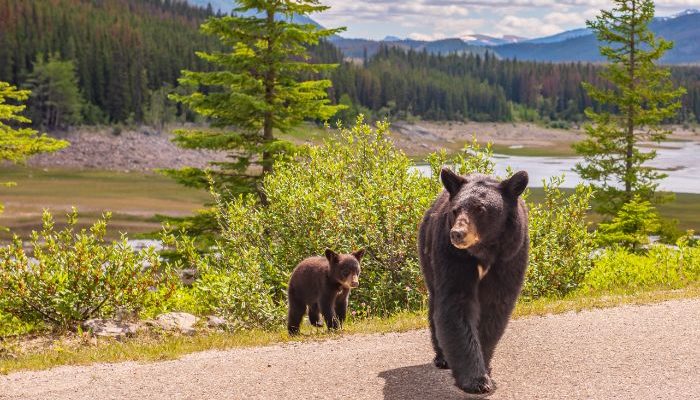
What other wildlife might you encounter
The tourist information brochure also provides advice on what to do if you encounter deer, bighorn sheep, mountain goats, wolves, cougars and coyotes. Good job I only read the elk section or I would have been getting the next bus out of town!!

Final thoughts
If you are as ‘Idiot Abroad’ as us when it comes to wild animals in Canada, I urge you to visit the tourist information and pick up the essential leaflets mentioned. Go discover the wildlife, respect it from a distance and carry bear spray!
Despite the dangers of wildlife in the Rockies, if you follow the guidance and use common sense, it is unlikely you will have any issues. What you will come away with however are incredible memories of some truly stunning animals. These will live with me far longer than the photos I failed to capture because I was far too excited to think about it.
We would love to hear your stories about any encounters. Feel free to share your travel tales in the comments below if you have any wildlife memories of note.
 From Miles to Smiles Stylish travel for professionals seeking luxury at affordable prices
From Miles to Smiles Stylish travel for professionals seeking luxury at affordable prices
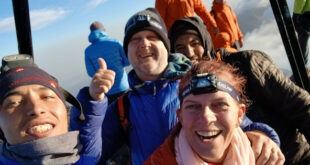
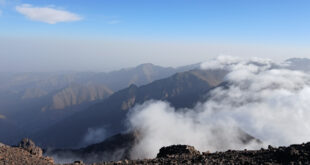

You could write a pamphlet entitled “Death In The Wild”. Awesome writeup!
Ha ha so true but it might put someone off going to an incredible place, 😂
You do mention making noise but you left out a very important element, bear bells. Yes there are jokes to be made about them but they work. Living in Montana, I never go out hiking without bear bells and bear spray.
Ooh. That is interesting. I read about the bear bells and the answers were mixed as to how effective they were. I still don’t quite understand how the bear spray works but I read a lot about the positive impact that can have so do feel free to share any other experiences.
By the way Montana is so on my bucket list. The mountains and ski areas look amazing!